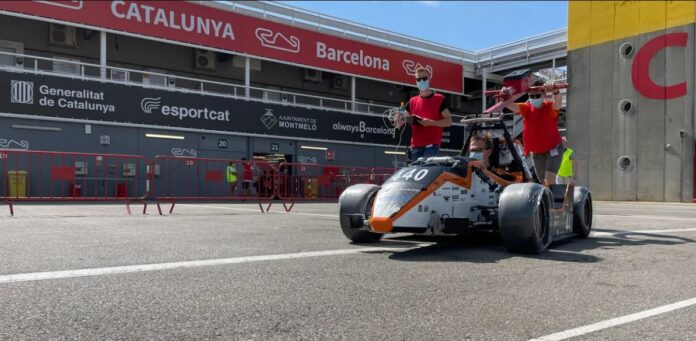It was a great shock: the URE 15 electric racing car burned down under the watchful eye of the students. Less than six months later, however, the students have built a new car: the URE16. The new car will be presented on Thursday afternoon.
That URE16 (named after the student team: University Racing Eindhoven, ed.), had to be built without the students being able to fall back on the old model.
“That indeed made the task more difficult,” says Joos Kat, team manager of URE. “Normally we can use the old car when testing software and hardware. We didn’t have that option now, so we had to use an even older model for those tests – not ideal.”
‘Always alert’
But the students have learned from the accident. “It was a severe shock for everyone but the most important thing is that no one was hurt. The driver was able to get out of the car quickly enough. We have now built in extra security. With the previous car, we met all safety requirements. We have learned that even though you follow all the procedures, you always have to stay alert.”
“The value of building the car is the experience we gain with it, we make everything ourselves.”
Joos Kat, team manager of URE
But burned down or not, the autonomous racing car URE 16 has changed a lot from the previous model. This was not by necessity, Kat explains. “Those plans were already there before we lost the previous model.”
Conversion
“The drive shaft used to have 400 volts, which is now 600 volts. We have designed a new battery pack and new engines,” the team manager explains. “The biggest change compared to the URE15? It’s in the design of the chasis. With the previous car it took us four hours to build it up from a self-driving model to a controllable model. That is no longer necessary. We have built all the functions for autonomous driving into the chassis. Conversion now only takes a few seconds.”
Prizes
With these changes, the student team wants to compete again for the prizes for both autonomous racing and electric racing. “At the autonomous race last year in Spain, we came first,” says Kat. “With driver in the car, we came second in Assen. We want to compete for prizes with this car too.”
Because with those awards, the students get a confirmation of their good work, Kat explains. “It’s not like we’ll immediately come up with innovations with this car that we could apply in industry when we’re done studying. The value of building the car is the experience we gain with it. We make everything ourselves, write the software ourselves. That practical knowledge is enormously valuable when we start our careers.”
Full calendar
But it is not that far yet. First, the students have a summer full of races ahead of them. “In three and a half weeks we will be in Assen for the electric race. In mid-August there is an unofficial world championship in Germany, where we will race both autonomous and electric, and we finish again in Barcelona, with the autonomous race,” Kat says.
Source: Studio040
















